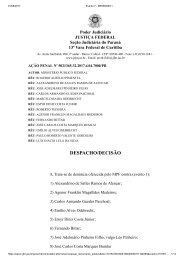Brasil só deve dominar Leitura em 260 anos, aponta estudo do Banco Mundial Relatorio Banco Mundial _Learning
You also want an ePaper? Increase the reach of your titles
YUMPU automatically turns print PDFs into web optimized ePapers that Google loves.
Box 3.1 Thosewhocan’treadbytheen<strong>do</strong>fgrade2struggletocatchup<br />
Illiteracy at the end of grade 2 has long-term consequences<br />
for two reasons. First, learning is cumulative. Education<br />
syst<strong>em</strong>s around the world expect students to acquire foundational<br />
skills such as reading by grades 1 or 2. By grade 3,<br />
students need to read to access their curriculum. Students<br />
who master these foundational skills early are at an<br />
advantage: skills from early grades are strongly positively<br />
associated with later school performance (see spotlight<br />
1). a Children who cannot read by grade 3 fall behind and<br />
struggle to catch up, perhaps irreparably. b<br />
Second, schools <strong>do</strong> not offer struggling students a chance<br />
to catch up. In many contexts, the pace of classroom instruction<br />
is determined by the need to cover an overly ambitious<br />
curriculum rather than by the pace of student learning. c This<br />
means teachers have no choice but to ignore students who are<br />
falling behind. In India and Kenya, for example, the curriculum<br />
has been designed for the elite. d Teachers and textbooks focus<br />
on advanced topics that are of little use in helping struggling<br />
students. e These students then fall even further behind—<br />
eventually so far that no learning whatsoever takes place. f<br />
Source: WDR 2018 team.<br />
a. Glick and Sahn (2010).<br />
b. Muralidharan and Zieleniak (2013).<br />
c. Pritchett and Beatty (2012).<br />
d. Banerjee and Duflo (2012); Glewwe, Kr<strong>em</strong>er, and Moulin (2009).<br />
e. Pritchett and Beatty (2012).<br />
f. Pritchett and Beatty (2012).<br />
of Vietnam reinforces that lesson; it, too, has maintained<br />
education quality during rapid expansion by<br />
ensuring that disadvantaged students receive relatively<br />
equitable access to quality schooling. 11<br />
Even in middle-income countries, millions of<br />
students are lagging behind. In Brazil, internationally<br />
comparable assessments reveal that more than<br />
three-quarters of youth are reaching the age of 15<br />
without being able to perform at the lowest level of<br />
competence on the Programme for International<br />
Student Assessment (PISA) tests. 12 Similarly, a third of<br />
students in Paraguay have only a basic grasp of reading<br />
skills (“reading for meaning”) by grade 6. 13 These<br />
students are therefore ill-equipped to participate<br />
in their economy and society. 14 These numbers also<br />
show interesting gender-based differences (box 3.2).<br />
However, some countries are <strong>do</strong>ing better.<br />
Albania, Peru, and Portugal have made impressive<br />
progress in improving average student achiev<strong>em</strong>ent<br />
relative to countries with similar incomes. 15 Latvia<br />
outperforms several countries in eastern Europe;<br />
Vietnam is a positive outlier in Southeast Asia.<br />
Although it is not always possible to clearly isolate<br />
the factors responsible for syst<strong>em</strong>wide improv<strong>em</strong>ents<br />
in student learning, a policy focus on education<br />
quality appears to be important. For example, a<br />
major component of Vietnam’s strong performance<br />
has been a convergence in school quality within the<br />
country. The share of schools that meet the national<br />
standards of quality has steadily increased over the<br />
last 25 years. 16<br />
Low student achiev<strong>em</strong>ent in some middle-income<br />
countries relative to their economic competitors<br />
signals a failure to live up to their own expectations.<br />
According to the leading international assessments<br />
of literacy and numeracy, the average student in<br />
low-income countries performs worse than 95 percent<br />
of the students in Organisation for Economic Co-operation<br />
and Development (OECD) countries—meaning<br />
that student would be singled out for r<strong>em</strong>edial attention<br />
in a class in a wealthier country. 17 In Colombia,<br />
In<strong>do</strong>nesia, and Peru, student performance at the 75th<br />
percentile on the PISA math test is barely above that<br />
at the 25th percentile of the OECD average. In Algeria,<br />
the Dominican Republic, Kosovo, and Tunisia, it is<br />
below the 25th percentile of the OECD average (figure<br />
3.4). The disparity between the average PISA score<br />
for Latin American countries and OECD countries is<br />
equivalent to over two full years of math education.<br />
Based on its rate of progress in average PISA scores<br />
from 2003 to 2015, it would take Tunisia over 180 years<br />
to reach the OECD average in math. This slow rate<br />
of improv<strong>em</strong>ent is especially probl<strong>em</strong>atic for middleincome<br />
countries trying to position th<strong>em</strong>selves as<br />
important players in the global economic landscape.<br />
The mapping between schooling and workforce<br />
skills varies dramatically across countries. For example,<br />
the working-age population in Colombia reaches<br />
74 | World Development Report 2018








